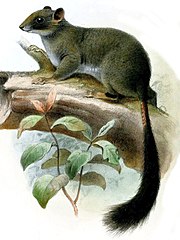Nielotka
rodzaj gryzoni
Nielotka[3] (Zenkerella) – rodzaj ssaków z rodziny nielotek (Zenkerellidae).
| Zenkerella | |||
| Matschie, 1898[1] | |||
 Przedstawiciel rodzaju – nielotka drzewna (Z. insignis) na ilustracji z 1898 roku | |||
| Systematyka | |||
| Domena | |||
|---|---|---|---|
| Królestwo | |||
| Typ | |||
| Podtyp | |||
| Gromada | |||
| Podgromada | |||
| Infragromada | |||
| Rząd | |||
| Podrząd | |||
| Infrarząd | |||
| Rodzina | |||
| Rodzaj |
nielotka | ||
| Typ nomenklatoryczny | |||
|
Zenkerella insignis Matschie, 1898 | |||
| Synonimy | |||
|
| |||
| Gatunki | |||
| |||
Zasięg występowania
edytujRodzaj obejmuje jeden żyjący współcześnie gatunek występujący w zachodniej Afryce[4][5].
Morfologia
edytujDługość ciała (bez ogona) 180–230 mm, długość ogona 150–180 mm; masa ciała 180–220 g[6][7].
Systematyka
edytujRodzaj zdefiniował w 1898 roku niemiecki zoolog Paul Matschie na łamach rocznika Sitzungsberichte der Gesellschaft Naturforschender Freunde zu Berlin[1]. Na gatunek typowy Matschie wyznaczył nielotkę drzewną (Z. insignis).
Etymologia
edytuj- Zenkerella: Georg August Zenker (1855–1922), niemiecki botanik, podróżnik, kolekcjoner, kolonista w Kamerunie w latach 1889–1922; łac. przyrostek zdrabniający -ella[8][9].
- Aethurus: gr. αηθης aēthēs „dziwny”, od negatywnego przedrostka α- a-; ηθος ēthos „zwyczajny”; ουρα oura „ogon”[10]. Gatunek typowy: Aëthurus glirinus de Winton, 1898 (= Zenkerella insignis Matschie, 1898).
Podział systematyczny
edytujDo rodzaju należy jeden występujący współcześnie gatunek[11][7][4][3]:
- Zenkerella insignis Matschie, 1898 – nielotka drzewna
Opisano również gatunek wymarły z miocenu Kenii[12]:
- Zenkerella wintoni Lavocat, 1973
Przypisy
edytuj- ↑ a b P. Matschie. Eine neue mit Idiurus Mtsch. verwandte Gattung der Nagethiere. „Sitzungsberichte der Gesellschaft Naturforschender Freunde zu Berlin”. Jahrgang 1898, s. 23, 1898. (niem.).
- ↑ W.E. de Winton. On a new genus and species of rodents of the family Anomaluridae, from West Africa. „Proceedings of the Zoological Society of London”. 1898 (3), s. 451, 1898. (ang.).
- ↑ a b Nazwy zwyczajowe za: W. Cichocki, A. Ważna, J. Cichocki, E. Rajska-Jurgiel, A. Jasiński & W. Bogdanowicz: Polskie nazewnictwo ssaków świata. Warszawa: Muzeum i Instytut Zoologii PAN, 2015, s. 285. ISBN 978-83-88147-15-9. (pol. • ang.).
- ↑ a b C.J. Burgin, D.E. Wilson, R.A. Mittermeier, A.B. Rylands, T.E. Lacher & W. Sechrest: Illustrated Checklist of the Mammals of the World. Cz. 1: Monotremata to Rodentia. Barcelona: Lynx Edicions, 2020, s. 312. ISBN 978-84-16728-34-3. (ang.).
- ↑ D.E. Wilson & D.M. Reeder (redaktorzy): Genus Zenkerella. [w:] Mammal Species of the World. A Taxonomic and Geographic Reference (Wyd. 3) [on-line]. Johns Hopkins University Press, 2005. [dostęp 2023-01-27].
- ↑ S. Jackson: Family Anomaluridae (Anomalures). W: D.E. Wilson, T.E. Lacher, Jr & R.A. Mittermeier (redaktorzy): Handbook of the Mammals of the World. Cz. 6: Lagomorphs and Rodents I. Barcelona: Lynx Edicions, 2016, s. 279. ISBN 978-84-941892-3-4. (ang.).
- ↑ a b Class Mammalia. W: Lynx Nature Books: All the Mammals of the World. Barcelona: Lynx Edicions, 2023, s. 202. ISBN 978-84-16728-66-4. (ang.).
- ↑ Palmer 1904 ↓, s. 714.
- ↑ B. Beolens, M. Watkins & M. Grayson: The Eponym Dictionary of Mammals. Baltimore: The Johns Hopkins University Press, 2009, s. 459. ISBN 978-0-8018-9304-9. (ang.).
- ↑ Palmer 1904 ↓, s. 83.
- ↑ N. Upham, C. Burgin, J. Widness, M. Becker, C. Parker, S. Liphardt, I. Rochon & D. Huckaby: Treeview of Mammalian Taxonomy Hierarchy. [w:] ASM Mammal Diversity Database (Version 1.11) [on-line]. American Society of Mammalogists. [dostęp 2023-09-29]. (ang.).
- ↑ R. Lavocat. Les rongeurs du Miocène d’Afrique Orientale, Miocène inférieur. „Memoires et Travaux de l’Institut de Montpellier de l’Ecole Pratique des Hautes Etudes”. 1, s. 193, 1973. (fr.).
Bibliografia
edytuj- T.S. Palmer. Index Generum Mammalium: a List of the Genera and Families of Mammals. „North American Fauna”. 23, s. 1–984, 1904. (ang.).